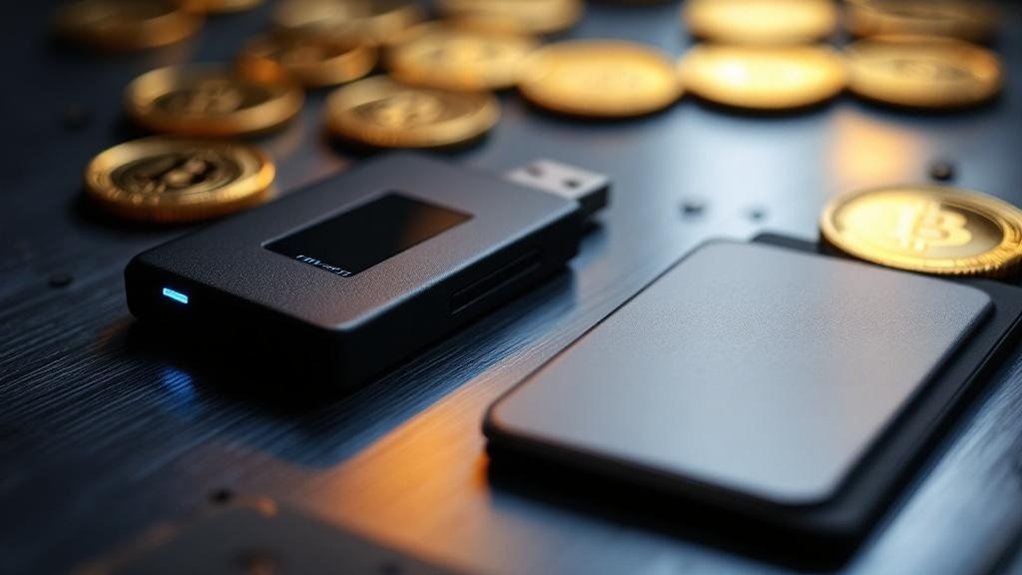A hardware wallet is a physical device that looks like a USB drive but acts as a fortress for cryptocurrency private keys. It keeps these essential keys completely offline and away from hackers, making it virtually immune to digital threats. The device handles sensitive operations internally while never exposing private keys to the internet. Think of it as a personal bank vault that fits in your pocket. There’s a whole world of security features to explore.

A hardware wallet is a physical device that brings cryptocurrency security into the real world. Looking like a simple USB drive, it’s actually a sophisticated vault for storing private keys – those precious strings of code that give access to crypto assets.
But here’s the clever part: the wallet doesn’t actually store cryptocurrencies. Nope. It holds the keys that control them, keeping them safely offline and away from greedy hackers.
Think of it as a fortress for digital assets. The private keys stay locked inside a protected microcontroller, never exposed to the internet’s dangers.
Like an impenetrable digital castle, hardware wallets shield your crypto’s most vital keys behind secure walls, far from online threats.
When you need to make a transaction, the device handles all the sensitive operations internally. Your computer never sees those private keys – it just gets the final signed transaction. Pretty smart, right?
And unlike software wallets living on vulnerable computers, hardware wallets remain immune to viruses and malware. You’ll need to enter a PIN to access your wallet’s contents.
The beauty lies in its simplicity.
Most hardware wallets can manage multiple cryptocurrencies from different exchanges simultaneously.
Just like smart contracts require security audits to ensure integrity, hardware wallets undergo rigorous testing to protect users’ assets.
Connect it to your computer, verify the transaction on the device’s screen, press a button, and you’re done.
The wallet generates public keys for receiving funds while keeping the private keys tucked away safe and sound.
If disaster strikes and you lose the device, no problem – most hardware wallets provide recovery seed phrases to restore access to your funds.
Since their introduction in 2014 with the Trezor Model One, hardware wallets have revolutionized how people secure their crypto assets.
Companies like Ledger followed suit, adding features like biometric authentication and Bluetooth connectivity.
The core principle remains unchanged: giving users complete control over their private keys without relying on exchanges or third parties.
It’s a stark contrast to keeping crypto on exchanges, where you’re fundamentally trusting someone else with your digital gold.
With a hardware wallet, you’re the boss.
No more worrying about exchange hacks or unauthorized access.
Just pure, offline security in a pocket-sized package.
For serious crypto holders, it’s become an essential tool in the digital asset world.
Frequently Asked Questions
Can I Recover My Crypto if I Forget My Hardware Wallet PIN?
If someone forgets their hardware wallet PIN, they can absolutely recover their crypto.
The device will reset after too many wrong PIN attempts – completely wiped clean. No biggie though.
The recovery seed phrase, created during initial setup, is the golden ticket. Just reinitialize the wallet using those 12-24 backup words, set a new PIN, and boom – full access restored.
What Happens to My Coins if the Hardware Wallet Company Goes Bankrupt?
Nothing happens to the coins if the hardware wallet company goes bankrupt.
Seriously – nothing. That’s because hardware wallets are non-custodial devices where users control their own private keys.
The company never has access to the funds. Even if the manufacturer disappears completely, the wallet keeps working.
Users can still access their crypto using their seed phrase on other compatible wallets.
Is It Safe to Buy a Used Hardware Wallet?
Buying a used hardware wallet is a risky move.
Previous owners could have tampered with the device, installed malicious firmware, or kept copies of recovery phrases. Physical access enables sophisticated attacks like power glitching and side-channel exploits.
Even worse, counterfeit devices flood secondary markets. Throw in potential human errors from setup mishaps, and used wallets become a security nightmare. Not exactly a bargain when crypto’s on the line.
Can Malware on My Computer Affect My Hardware Wallet?
Malware on a computer can absolutely interfere with hardware wallet operations.
While it can’t directly steal private keys, infected computers may display fake transaction details or manipulate the wallet interface. Nasty stuff.
The main risks come from malware trying to trick users during transaction signing or attempting to compromise firmware updates.
The hardware wallet’s security features help, but a compromised computer is still dangerous territory.
How Often Should I Update My Hardware Wallet’s Firmware?
Hardware wallet firmware updates typically roll out every few months to over six months, depending on security needs and new feature developments.
No fixed schedule exists – updates drop when vulnerabilities need patching or new blockchain standards emerge. Smart users monitor official channels for update announcements.
Keeping firmware current is vital – it patches security holes and adds support for evolving crypto technologies.
